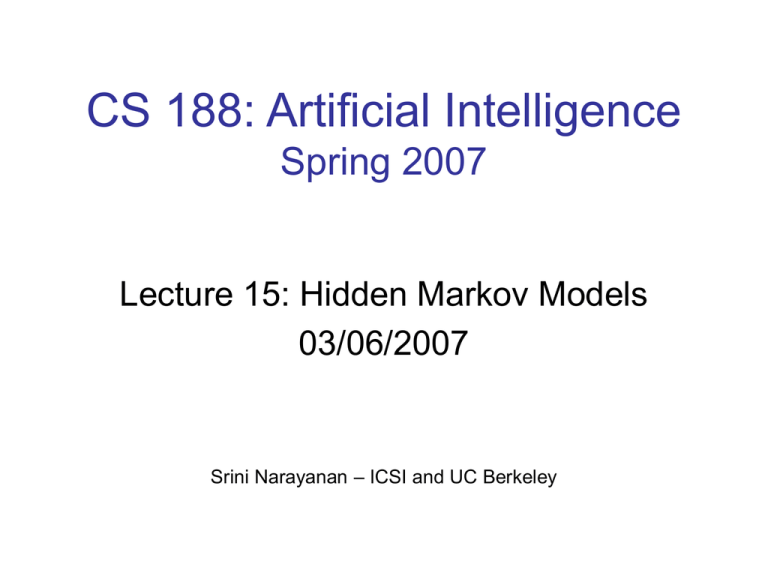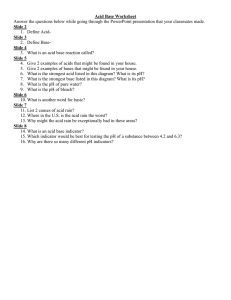HMMs
advertisement

CS 188: Artificial Intelligence
Spring 2007
Lecture 15: Hidden Markov Models
03/06/2007
Srini Narayanan – ICSI and UC Berkeley
Announcements
Midterm
On Tuesday 3/13 in class
Review page with previous exams posted
3/8 class will be a review.
HW 3 solutions posted.
HW 4 due tonight (midnight)
Reasoning over Time
Often, we want to reason about a sequence of
observations
Speech recognition
Robot localization
User attention
Medical monitoring
Need to introduce time into our models
Basic approach: hidden Markov models (HMMs)
More general: dynamic Bayes’ nets
Markov Models
A Markov model is a chain-structured BN
Each node is identically distributed (stationarity)
Value of X at a given time is called the state
As a BN:
X1
X2
X3
X4
Parameters: called transition probabilities or
dynamics, specify how the state evolves over time
(also, initial probs)
Conditional Independence
X1
X2
X3
X4
Basic conditional independence:
Past and future independent of the present
Each time step only depends on the previous
This is called the (first order) Markov property
Note that the chain is just a (growing BN)
We can always use generic BN reasoning on it (if we
truncate the chain)
Example: Markov Chain
0.1
Weather:
States: X = {rain, sun}
Transitions:
0.9
rain
sun
0.9
0.1
This is a
CPT, not a
BN!
Initial distribution: 1.0 sun
What’s the probability distribution after one step?
Mini-Forward Algorithm
Question: probability of being in state x at time t?
Slow answer:
Enumerate all sequences of length t which end in s
Add up their probabilities
…
Mini-Forward Algorithm
Better way: cached incremental belief updates
sun
sun
sun
sun
rain
rain
rain
rain
Forward simulation
Example
From initial observation of sun
P(X1)
P(X2)
P(X3)
P(X)
From initial observation of rain
P(X1)
P(X2)
P(X3)
P(X)
Stationary Distributions
If we simulate the chain long enough:
What happens?
Uncertainty accumulates
Eventually, we have no idea what the state is!
Stationary distributions:
For most chains, the distribution we end up in is
independent of the initial distribution
Called the stationary distribution of the chain
Usually, can only predict a short time out
Web Link Analysis
PageRank over a web graph
Each web page is a state
Initial distribution: uniform over pages
Transitions:
With prob. c, uniform jump to a
random page (dotted lines)
With prob. 1-c, follow a random
outlink (solid lines)
Stationary distribution
Will spend more time on highly reachable pages
E.g. many ways to get to the Acrobat Reader download page!
Somewhat robust to link spam
Google 1.0 returned the set of pages containing all your
keywords in decreasing rank, now all search engines use link
analysis along with many other factors
Most Likely Explanation
Question: most likely sequence ending in x at t?
E.g. if sun on day 4, what’s the most likely sequence?
Intuitively: probably sun all four days
Slow answer: enumerate and score
…
Mini-Viterbi Algorithm
Better answer: cached incremental updates
sun
sun
sun
sun
rain
rain
rain
rain
Define:
Read best sequence off of m and a vectors
Mini-Viterbi
sun
sun
sun
sun
rain
rain
rain
rain
Hidden Markov Models
Markov chains not so useful for most agents
Eventually you don’t know anything anymore
Need observations to update your beliefs
Hidden Markov models (HMMs)
Underlying Markov chain over states S
You observe outputs (effects) at each time step
As a Bayes’ net:
X1
X2
X3
X4
X5
E1
E2
E3
E4
E5
Example
An HMM is
Initial distribution:
Transitions:
Emissions:
Conditional Independence
HMMs have two important independence properties:
Markov hidden process, future depends on past via the present
Current observation independent of all else given current state
X1
X2
X3
X4
X5
E1
E2
E3
E4
E5
Quiz: does this mean that observations are independent
given no evidence?
[No, correlated by the hidden state]
Forward Algorithm
Can ask the same questions for HMMs as Markov chains
Given current belief state, how to update with evidence?
This is called monitoring or filtering
Formally, we want:
Example
Viterbi Algorithm
Question: what is the most likely state sequence given
the observations?
Slow answer: enumerate all possibilities
Better answer: cached incremental version
Example
Real HMM Examples
Speech recognition HMMs:
Observations are acoustic signals (continuous valued)
States are specific positions in specific words (so, tens of
thousands)
Machine translation HMMs:
Observations are words (tens of thousands)
States are translation positions (dozens)
Robot tracking:
Observations are range readings (continuous)
States are positions on a map (continuous)
Dynamic Bayes Nets
DBN = Multiple Hidden State Variables. Each State is a BN
Structured
Probabilistic Inference




